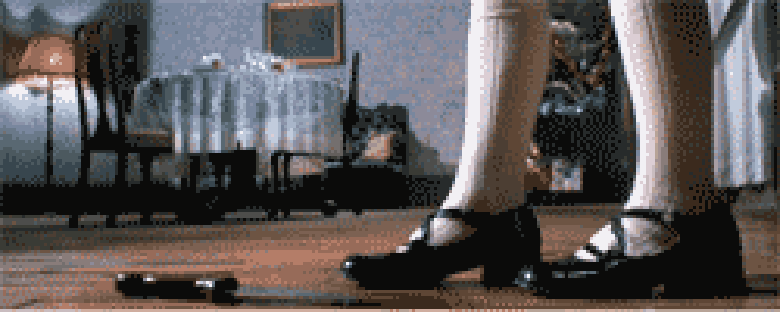Reviews
Profondo Rosso / The Hatchet Murders
Dario Argento
Italy, 1975
Credits
Review by Thomas Scalzo
Posted on 10 April 2006
Source Anchor Bay DVD
Related articles
Reviews: Deep Red (by Rumsey)
After witnessing a brutal death, an inquisitive jazz pianist named Marc finds himself embroiled in an enigmatic, and supremely gory, murder-mystery—and at the top of the local law enforcement’s suspect list. As Marc tries his best to both solve the case and clear his good name, acquaintances both intimate and casual begin perishing in grotesque and violent ways. Although such a plot might seem a bit hackneyed, in the hands of Dario Argento it becomes both a relentless, engrossing, and surprising thriller, and a memorably graphic horror film.
What keeps the film moving along at a frenetic pace, aside from Marc’s relentless quest for the truth that inextricably draws him to each new horrific realization, is a groovy funk/rock soundtrack, composed and performed by The Goblins. At first listen, the rollicking tunes seem to be at odds with the film’s subdued tension, but as the story progresses, we realize that the pulse-pounding beats continuously serve to both keep the viewer engaged during some of the slower sections, and to maintain an atmosphere of frenzy and disconcertion throughout the film as a whole.
Examining one of the many haunted-house scenes serves to exemplify this idea. Marc, in an effort to understand the connection between a decrepit mansion and his murderistic quarry, spends an afternoon skulking about the dilapidated place. As he creeps from room to room, the soundtrack kicks into high gear; an exuberant and catchy rhythm taking center stage. All of a sudden, Marc steps on a piece of glass. It shatters. The music cuts off. Marc swivels around to see what made the noise. Unprepared for the sudden cessation of sound, we are caught off guard and thrust headlong into a scene charged with tension and foreboding. For a few beats we hold our breath and anticipate the awful. But nothing materializes. A moment later, Marc continues his search, the music revives, and the repetitive riffs once again usher us helplessly along. It is a scene utterly lacking in tangible horror, and yet, owing to Argento’s deft auditory incorporations, we are left on edge, all the more susceptible to the truly horrific scenes to come.
Soundtrack and storytelling techniques aside, the influence of Deep Red’s central plot elements, particularly on the American slasher films of the ’80s, cannot be ignored. When we factor in Argento’s grim visualization of several memorable and creatively orchestrated death sequences (the scalding hot water demise is my favorite); the killer’s preference for an unusually gruesome weapon (a large hatchet); and the inclusion of a traumatized youth, an overly devoted mother, and a morally casual yet irrepressibly inquisitive female reporter; it is nearly impossible to examine an American slasher from the ’80s and not find one or more of these Deep Red-inspired touches.
Of course, untold slasher aficionados out there will quickly point out that Deep Red cannot correctly be dubbed the progenitor of the genre (Mario Bava’s Twitch of the Death Nerve, for one, holds a strong claim on that title). However, Argento’s work unquestionably imbued the fledgling genre with an artistic flair and narrative complexity that it had seldom seen before, and continues to serve as a slasher touchstone that has rarely been matched.
We don’t do comments anymore, but you may contact us here or find us on Twitter or Facebook.



